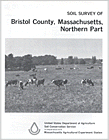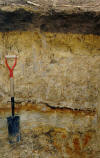Soil Survey of Bristol County, Massachusetts
NORTHERN PART

The following Map Unit Description is from the 1981 Soil Survey of Bristol County, NORTHERN Part. Please note: map unit symbols are DIFFERENT for Bristol North and Bristol South reports, do NOT use these descriptions for Bristol South.
ScA-Scio silt loam, 0 to 3 percent slopes. This soil is deep, nearly level, and moderately well drained. It is near the larger streams. Slopes are smooth or undulating and are generally 200 to 300 feet long. The mapped areas are irregular in shape and range from 5 to 10 acres in size.
Typically, the surface layer is very friable, dark brown silt loam about 8 inches thick. The subsoil is 18 inches thick. It is friable, yellowish brown silt loam in the upper part and firm, mottled, light olive brown silt loam in the lower part. The substratum to a depth of 66 inches is firm, grayish brown silt loam that has many reddish brown mottles.
Included with this soil in mapping are areas of Unadilla and Raynham soils that are generally less than 3 acres in size. Included soils make up about 20 percent .of the map unit.
Permeability is moderate in the subsoil. Available water capacity is high. The root zone is restricted by a seasonal high water table. In unlimed areas reaction is very strongly acid to medium acid.
This soil has good potential for farming, and most acreage has been farmed. It has fair or poor potential for urban use and poor potential for sanitary waste disposal facilities. The soil has good potential for trees and for openland and woodland wildlife habitat. Some acreage is in woodland. Some areas of soils are used for homesites.
The soil is suited to cultivated crops, hay, and pasture. Good tilth is easily maintained. The seasonal high water table is the major concern of management. The hazard of erosion is slight. Conservation management includes improving tilth, increasing organic-matter content, and installing subsurface drains if needed. Mixing crop residue and animal manure into the plow layer helps to improve tilth and increase organic-matter content. Proper stocking rates, deferred grazing, and pasture rotation are management practices that help to maintain desirable pasture plants.
The soil has few limitations for trees but only a small acreage is in woodland. Productivity is high. Important tree species are eastern white pine and red oak.
The soil has limitations for urban use because of a seasonal high water table and high potential frost action. The seasonal high water table is a limitation for sanitary waste disposal facilities. Capability subclass IIw.
ScB-Scio silt loam, 3 to 8 percent slopes. This soil is deep, gently sloping, and moderately well drained. It is near the larger streams. Slopes are smooth or undulating and are generally 200 to 300 feet long. The mapped areas are irregular in shape and range from 5 to 10 acres in size.
Typically, the surface layer is very friable, dark brown silt loam about 8 inches thick. The subsoil is 18 inches thick. It is friable, yellowish brown silt loam in the upper part and firm, mottled, light olive brown silt loam in the lower part. The substratum to a depth of 66 inches is firm, grayish brown silt loam that has many reddish brown mottles.
Included with this soil in mapping are areas of Unadilla and Raynham soils that are generally less than 3 acres in size. Included soils make up about 20 percent of the map unit.
Permeability is moderate in the subsoil. Available water capacity is high. The root zone is restricted by a seasonal high water table. In unlimed areas reaction is very strongly acid to medium acid.
This soil has good potential for farming and most acreage has been farmed. It has fair to poor potential for urban use and poor potential for sanitary waste disposal facilities. This soil has good potential for trees and for open land and woodland wildlife habitat. Some acreage is in woodland and some areas of soils are in homesites.
The soil is suited to cultivated crops, hay, and pasture. Good tilth is easily maintained. The hazard of erosion is moderate. Conservation management includes controlling erosion, improving tilth, increasing organic-matter content, and installing subsurface drains where needed. If this soil is farmed, the use of minimum tillage, cover crops, and grasses and legumes in the cropping system help to reduce runoff and control erosion. Mixing crop residue and animal manure into the plow layer helps to improve tilth and increase organic-matter content. Proper stocking rates, deferred grazing, and pasture rotation help to maintain desirable plant species.
The soil has few limitations for trees, but only a small acreage is wooded. Productivity is high. Important tree species are eastern white pine and red oak.
The soil has limitations for urban use because of a seasonal high water table and high potential frost action. The seasonal high water table is a limitation for sanitary waste disposal facilities. Capability subclass IIw.
